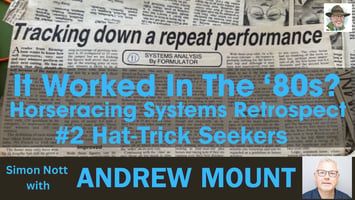MAKING THOSE NURSERIES PAY This week’s ‘It Worked in the 80s’ looks at another Systems Analysis by...
Horseracing Systems #8 with Andrew Mount - Blinkers!
BLINKERS
This week’s episode is inspired by Nick Mordin’s 1992 book ‘Betting for a Living’, the publication that inspired me to take my betting more seriously.
Page 86 discusses blinkers and the effect they have on racehorses…
“The most obvious effect of blinkers…is to scare the horse into running faster in the early stages. The horses can’t see what’s behind going on behind it, so it take’s flight and flees. This means that a blinkered horse will take an early lead much more than often, as you can see from the random sample of 100 blinkered horses:
Runs Led or disputed lead before halfway
Last run without blinkers 100 6
First run with blinkers 100 28
Second run with blinkers 100 7
…a horse will lead or dispute the lead in the early stages almost five times as often if you fit blinkers for the first time.”
Let’s see if that still holds true…
There have been 5962 first-time blinkered runners in Britain since racing resumed after COVID in June 2020 and these were there run styles (L = led, P = prominent, H = held up)…

Of the 1182 who made the running, 132 of them won (11.17% strike-rate) for a profit of £83.11 to a £1 level stake at SP (+£424.27 at Betfair SP after 2% commission). Those ridden prominently won 8.82% of their races, while hold-up horses had a strike-rate of just 5.82%. The 11 horses without a Proform pace abbreviation didn’t get far enough to receive one (e.g. refused to race, whipped round and unseated rider start).
Splitting the 1182 front-runners by last-time out pace abbreviation gives the following results.

Interestingly, those ridden patiently last time out had were the ones who were profitable to back. In total only 208 of the 1182 made the running last time out, making them almost six times as likely to make the running in first-time blinkers, not far off the figure mentioned by Mordin. The author goes on to conclude the horses having their second run in blinkers have a superior strike-rate (10.7%) to those wearing first-time blinkers (6.9%). The horses in my sample won at a slightly higher rated in first-time blinkers (8.03%)

…though those who wore the blinkers again on their next run did improve their strike-rate significantly (11.93%)…

Mordin goes on to discuss the effect of race distance on blinkered runners and comes up with the following system – back horses having their second run in blinkers that are switched to a shorter trip but not over 7f-1m2f. His sample found 19 winners from 166 runners (11.4%, +31.6% on turnover) for a profit of £52.53 to a £1 level stake at SP. Let’s run these figures and see if it still holds true. I’ve taken British Flat races (turf and all-weather) from 1 June 2020 and defined a drop in distance as being one furlong or more (I didn’t eliminate the 7f-1m2f trips)…

…remarkably the strike-rate (11.46%) is virtually identical to Mordin’s sample and while not profitable at SP it returned a profit of £52.96 at BSP (after comm) (+18.39% on turnover). Splitting by race type makes interesting reading…

…the turf runners showed a loss, but the all-weather qualifiers made a big profit at both SP and BSP.
These are the last time out running styles of the qualifiers….

…those ridden patiently when fitted with first-time blinkers on their latest outing fared poorly, landing just six of their 100 races and eliminating these from the sample gives the following results…

These races include all distances – eliminating the 7f-1m2f trips didn’t help, as there were good profits achieved at one mile. The downside with this system is the low strike-rate and the profit at SP is all thanks to one 66-1 winner.
Next, I looked at the same angle but for national hunt horses, i.e. second time blinkers, having led or raced prominently in first-time blinkers last time out, now dropping in distances (I used two furlongs instead of one furlong).

The hurdlers returned a loss, but the chasers exceeded market expectations by some way.
Summary
Back second-time blinkered runners on the Flat (especially the all-weather) and in chases who showed early speed (led or raced prominently) in first-time blinkers on their latest start that were now dropping in distance (one furlong or more on the Flat, two furlongs or more over jumps).
You can follow Andrew Mount's FREE advices every day here
https://gg.co.uk/authors/andrew-mount/
SERIOUS PUNTER?
If you have enjoyed this feature, aren't just a carpet bagger and don't already have an account with AK Bets, you might want to consider signing up, there's an introductory offer OF UP TO £100 via our link below. Mounty and I will get some commission if you sign up and lose, but with these articles we'll do our best to ensure you don't, plus he stands them so if you win, AK hurts! Please click below to add to his pain by bagging AK's BIG LIMITS AND BIG PRICES!
.png?width=394&height=222&name=It%20Worked%20In%20The%20%E2%80%9880s%20(10).png)
.png?width=200&height=200&name=Add%20a%20heading%20(38).png)
%20(1).gif?width=2784&height=342&name=1856x228%20(1)%20(1).gif)


